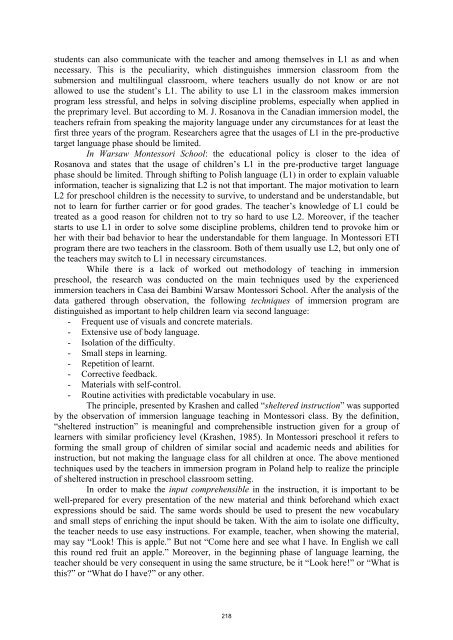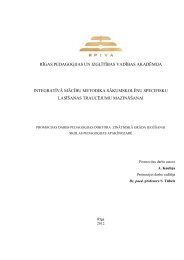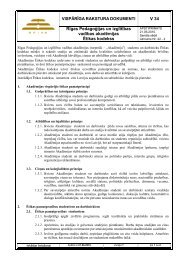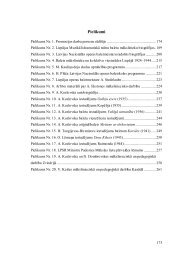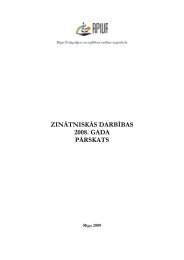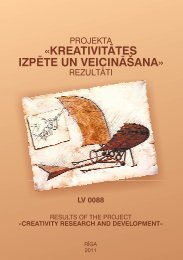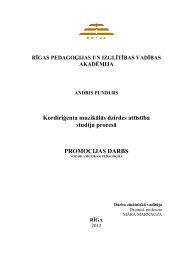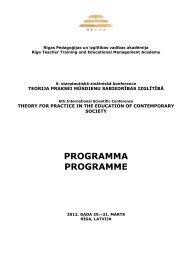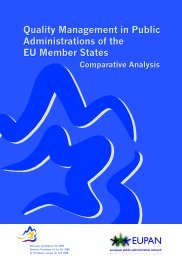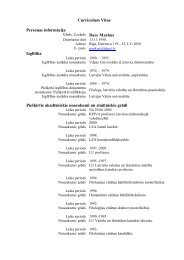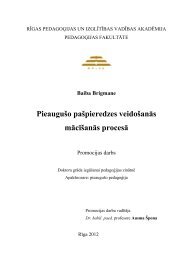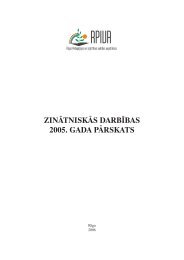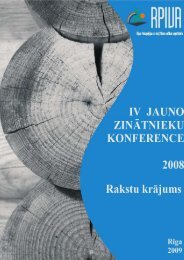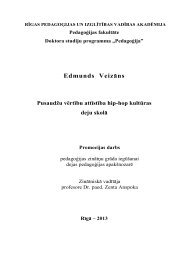saturs - rpiva
saturs - rpiva
saturs - rpiva
- No tags were found...
Create successful ePaper yourself
Turn your PDF publications into a flip-book with our unique Google optimized e-Paper software.
students can also communicate with the teacher and among themselves in L1 as and when<br />
necessary. This is the peculiarity, which distinguishes immersion classroom from the<br />
submersion and multilingual classroom, where teachers usually do not know or are not<br />
allowed to use the student’s L1. The ability to use L1 in the classroom makes immersion<br />
program less stressful, and helps in solving discipline problems, especially when applied in<br />
the preprimary level. But according to M. J. Rosanova in the Canadian immersion model, the<br />
teachers refrain from speaking the majority language under any circumstances for at least the<br />
first three years of the program. Researchers agree that the usages of L1 in the pre-productive<br />
target language phase should be limited.<br />
In Warsaw Montessori School: the educational policy is closer to the idea of<br />
Rosanova and states that the usage of children’s L1 in the pre-productive target language<br />
phase should be limited. Through shifting to Polish language (L1) in order to explain valuable<br />
information, teacher is signalizing that L2 is not that important. The major motivation to learn<br />
L2 for preschool children is the necessity to survive, to understand and be understandable, but<br />
not to learn for further carrier or for good grades. The teacher’s knowledge of L1 could be<br />
treated as a good reason for children not to try so hard to use L2. Moreover, if the teacher<br />
starts to use L1 in order to solve some discipline problems, children tend to provoke him or<br />
her with their bad behavior to hear the understandable for them language. In Montessori ETI<br />
program there are two teachers in the classroom. Both of them usually use L2, but only one of<br />
the teachers may switch to L1 in necessary circumstances.<br />
While there is a lack of worked out methodology of teaching in immersion<br />
preschool, the research was conducted on the main techniques used by the experienced<br />
immersion teachers in Casa dei Bambini Warsaw Montessori School. After the analysis of the<br />
data gathered through observation, the following techniques of immersion program are<br />
distinguished as important to help children learn via second language:<br />
- Frequent use of visuals and concrete materials.<br />
- Extensive use of body language.<br />
- Isolation of the difficulty.<br />
- Small steps in learning.<br />
- Repetition of learnt.<br />
- Corrective feedback.<br />
- Materials with self-control.<br />
- Routine activities with predictable vocabulary in use.<br />
The principle, presented by Krashen and called “sheltered instruction” was supported<br />
by the observation of immersion language teaching in Montessori class. By the definition,<br />
“sheltered instruction” is meaningful and comprehensible instruction given for a group of<br />
learners with similar proficiency level (Krashen, 1985). In Montessori preschool it refers to<br />
forming the small group of children of similar social and academic needs and abilities for<br />
instruction, but not making the language class for all children at once. The above mentioned<br />
techniques used by the teachers in immersion program in Poland help to realize the principle<br />
of sheltered instruction in preschool classroom setting.<br />
In order to make the input comprehensible in the instruction, it is important to be<br />
well-prepared for every presentation of the new material and think beforehand which exact<br />
expressions should be said. The same words should be used to present the new vocabulary<br />
and small steps of enriching the input should be taken. With the aim to isolate one difficulty,<br />
the teacher needs to use easy instructions. For example, teacher, when showing the material,<br />
may say “Look! This is apple.” But not “Come here and see what I have. In English we call<br />
this round red fruit an apple.” Moreover, in the beginning phase of language learning, the<br />
teacher should be very consequent in using the same structure, be it “Look here!” or “What is<br />
this” or “What do I have” or any other.<br />
218


